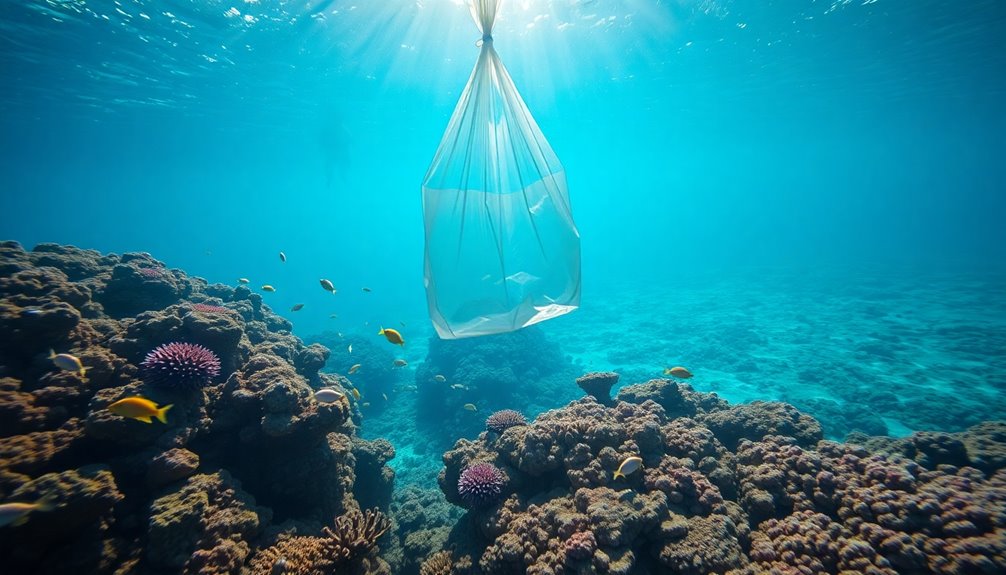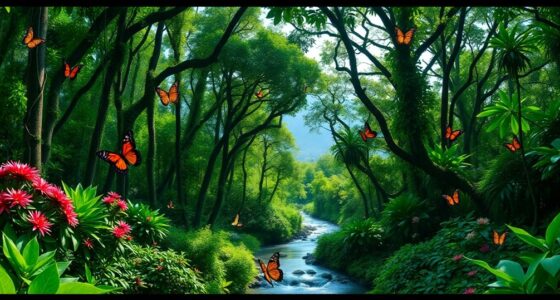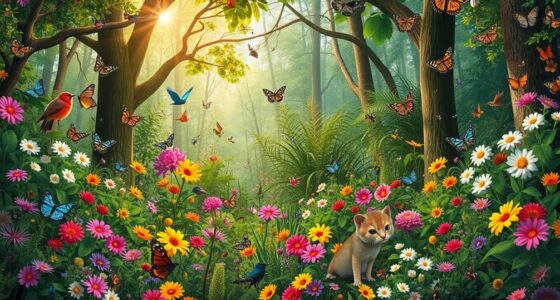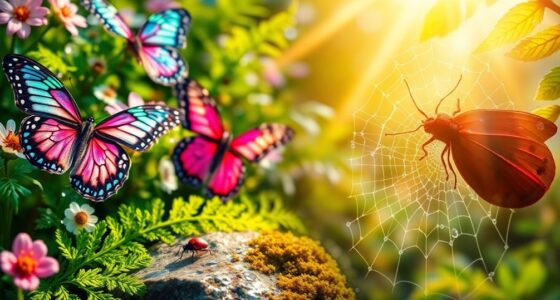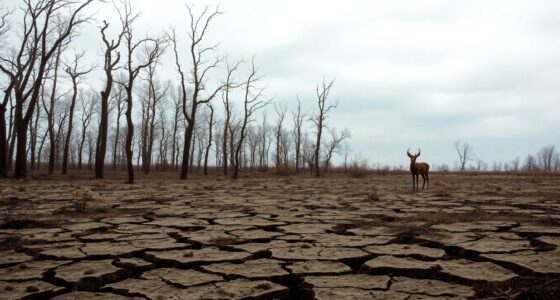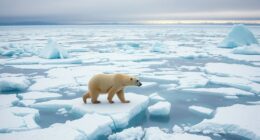The single greatest threat to biodiversity is habitat loss. Human activities have destroyed nearly 50% of tropical rainforests, resulting in up to 50,000 species vanishing each year. This destruction disrupts ecosystems and reduces genetic diversity, putting countless species at risk. As the population grows, demands for land and resources only intensify this issue. Understanding the broader implications of habitat loss is essential, and there's much more to uncover on this critical topic.
Key Takeaways
- Habitat loss due to human activities leads to the extinction of up to 50,000 species annually, threatening ecological balance.
- Climate change causes habitat unsuitability, particularly in polar regions, resulting in increased extinction rates across various species.
- Industrialized agricultural practices, including monoculture and pesticide use, degrade ecosystems and threaten pollinators vital for food security.
- Invasive species disrupt ecosystems by outcompeting native organisms, accelerating extinction rates and causing significant economic damage.
- Global conservation efforts, such as the 2023 High Seas Treaty, aim to address biodiversity loss through collaborative action and sustainable practices.
The Impact of Habitat Loss on Biodiversity

As human activities continue to reshape the planet, habitat loss stands out as the most pressing threat to biodiversity. Every time forests are cleared for agriculture or logging, countless species lose their homes, pushing them closer to extinction.
With nearly 50% of tropical rainforests destroyed, we're witnessing the loss of up to 50,000 species annually. This destruction disrupts ecosystems, threatening ecological balance and reducing genetic diversity.
Human population growth amplifies the demand for land and resources, further driving habitat loss and pollution. If we don't act, we risk collapsing food chains and entire ecosystems.
Effective conservation efforts are essential; by promoting sustainable land use and creating protected areas, we can mitigate habitat loss and preserve the rich biodiversity our planet depends on.
Climate Change: A Catalyst for Extinction

While climate change poses a myriad of challenges, its role as a catalyst for extinction can't be overstated.
You're witnessing a global crisis where species face dire consequences:
- Polar regions are becoming crowded as habitats become unsuitable.
- Coral reefs are bleached and acidified, endangering marine biodiversity.
- Coastal ecosystems are threatened by rising sea levels and flooding.
- Invasive species invade, outcompeting natives and disrupting ecosystems worldwide.
These factors contribute to significant habitat loss and escalating extinction rates, making the loss of biodiversity alarming.
With climate change driving these changes, species that once thrived now teeter on the brink of extinction.
It's a pressing issue that demands immediate action to mitigate biodiversity loss before it's too late.
Agricultural Practices and Their Role in Biodiversity Decline

Agricultural practices considerably impact biodiversity, often leading to alarming declines in various species. Human activities like industrialized farming dominate land use, causing habitat loss and fragmentation vital for wildlife. Monoculture reduces genetic diversity, making ecosystems more vulnerable to pests and diseases. The use of pesticides harms essential pollinators such as bees, threatening food security and overall ecosystem health. Additionally, chemical runoff from fertilizers creates dead zones in aquatic environments, drastically affecting fish populations.
| Impact Type | Description | Consequences |
|---|---|---|
| Habitat Loss | Land conversion for farming | Species decline |
| Monoculture | Single crop farming | Reduced genetic diversity |
| Chemical Runoff | Fertilizer runoff into waterways | Dead zones and fish loss |
| Pesticide Use | Insect population decline | Threatened pollinators |
Invasive Species: An Underestimated Threat

Invasive species pose a significant threat to biodiversity, often outcompeting native organisms for resources and disrupting ecosystems.
These non-native invaders can accelerate extinction rates and inflict severe economic damage.
Think about the impact:
- The brown tree snake decimated Guam's native bird population.
- Kudzu chokes out local flora, altering landscapes.
- The economic toll in the U.S. ranges from $125 to $140 billion annually.
- Climate change and global trade fuel their spread, intensifying this threat.
As invasive species dominate, they undermine the environmental benefits that healthy ecosystems provide.
Protecting biodiversity requires recognizing these underestimated threats and taking action to safeguard native species before they face extinction.
It's vital for the health of our planet.
Global Efforts and Policies for Biodiversity Conservation

As invasive species continue to threaten native ecosystems, global efforts are gaining momentum to combat biodiversity loss.
The 2023 High Seas Treaty aims to protect 30% of the world's oceans by 2030, emphasizing a commitment to marine biodiversity.
Additionally, COP15 established a Global Biodiversity Framework focused on genetic diversity and ecosystem restoration.
To tackle threats to biodiversity, countries are mobilizing funding and collaborating on effective environmental policies.
Reducing subsidies for pesticides and fertilizers will help combat habitat loss caused by intensive farming and promote sustainable practices.
Frequently Asked Questions
What Is the Greatest Threat to Biodiversity?
When you think about the greatest threat to biodiversity, it's crucial to reflect on how human activities impact ecosystems.
Habitat destruction, driven by logging, agriculture, and urban development, considerably reduces species populations. As you witness forests being cleared or wetlands drained, remember that these actions fragment habitats and create competition for resources.
Every time you choose sustainable options, you contribute to preserving the delicate balance of our planet's diverse life forms.
What Is Currently the Single Greatest Threat to Biodiversity?
Right now, the biggest threat to biodiversity is habitat loss.
You're seeing it everywhere, from deforestation to urban sprawl. As humans expand, nearly half of tropical rainforests are disappearing, and that's where so many species thrive.
Each year, around 50,000 species vanish due to this destruction, creating fierce competition among the survivors.
With climate change also playing a role, it's essential you understand the urgency of protecting these critical ecosystems.
What Is the Single Threat to Biodiversity?
They say, "You can't see the forest for the trees," and that's exactly what's happening.
Every day, you're witnessing the loss of habitats due to urban sprawl and agriculture, which threatens countless species. This relentless destruction leads to competition for resources, causing many to go extinct.
You mightn't realize it, but your choices can contribute to this issue. It's essential to think about how you interact with the environment and support conservation efforts.
What Is the Single Greatest Threat to Biodiversity in Quizlet?
When you're browsing Quizlet, you'll find that many sources highlight habitat destruction as a significant threat to biodiversity.
It's essential to understand how human activities like agriculture and urbanization contribute to this issue. You might notice that deforestation leads to massive species loss and ecosystem disruption.
Conclusion
In the face of formidable forces, you must recognize that habitat loss is a heavy hitter in the battle for biodiversity. Climate change, careless agriculture, and invasive intruders further fuel this fierce fight. By championing conservation, fostering collaboration, and embracing eco-friendly practices, you can help halt this heartbreaking decline. Every action counts; together, we can turn the tide and triumph over threats, ensuring a thriving tapestry of life for generations to come.
